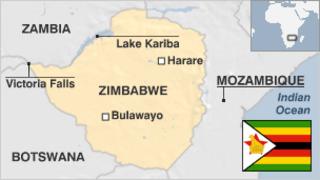Zimbabwe profile
The struggle for independence, land and power runs throughout Zimbabwe’s modern history. Veteran President Robert Mugabe dominated the country’s political scene for almost four decades after independence from Britain in 1980.
Once the bread basket of the region, since 2000 Zimbabwe has struggled to feed its own people due to severe droughts and the effects of a land reform programme that saw white-owned farms redistributed to landless Zimbabweans, with sharp falls in production.
The fall of Robert Mugabe in 2017 freed up politics and the media, but the country remains cash-strapped and impoverished.
Read profiles by BBC Monitoring
FACTS
Republic of Zimbabwe
Capital: Harare
Population 16.5 million
Area 390,759 sq km (150,873 sq miles)
Major languages English (official), Shona, Sindebele
Major religions Christianity, indigenous beliefs
Life expectancy 60 years (men), 64 years (women)
Currency Multi-currency system; US dollar and South African rand predominate
LEADER
President: Emmerson Mnangagwa
Emmerson Mnangagwa became president in November 2017 following a dramatic week in which the military took charge and Robert Mugabe resigned after 37 years in office.
After serving out Mr Mugabe’s term, Mr Mnangagwa was narrowly re-elected as president in a July 2018 election. The result was questioned by his closest opponent, MDC Alliance candidate Nelson Chamisa.
Mr Mnangagwa previously served as first vice-president from 2014 until his dismissal on 6 November 2017. Two weeks later, the ruling Zanu-PF party sacked Mr Mugabe as leader and appointed Mr Mnangagwa as party president.
He took part in the fight for independence in the 1960s and has held several key roles since independence in 1980.
Known as “the crocodile” because of his political cunning, he was associated with some of worst atrocities committed under the ruling Zanu-PF party.
Since his election as president, he has pledged open government and a programme to stabilise the ruined economy and boost foreign investment, but price hikes and high underlying inflation have led to street protests.
MEDIA
All broadcasters in Zimbabwe, and many of the main newspapers, toe the government line.
Radio is the main source of information. The state-run Zimbabwe Broadcasting Corporation (ZBC) operates TV and radio networks and two national private radio stations are licensed.
Read full profile
TIMELINE
Some key events in Zimbabwe’s history:
1200-1600 – Era of the Monomotapa Empire, noted for international trade, gold mining and the construction of Great Zimbabwe, now a World Heritage site.
1889-23 – Cecil Rhodes and his British South Africa Company uses British mandate to colonise what becomes Southern Rhodesia.
1965 – Prime Minister Ian Smith unilaterally declares independence from Britain under white-minority rule, leading to international isolation.
1980 – Independence following lengthy guerrilla war. Zanu party wins elections and Robert Mugabe becomes prime minister.
1983-87 – Gukurahundi campaign, in which 20,000 are thought to have been killed in Matabeleland by Mugabe’s Fifth Brigade. The violence ends following a unity accord, when the Zapu party is absorbed into the renamed governing Zanu-PF party.
1998-2002 – Zimbabwe intervenes in civil war in DR Congo.
2000s – Land redistribution: White farmers forced off land.
2008 – Opposition leader Morgan Tsvangirai beats Mugabe in the presidential election but is forced to withdraw from a run-off after his supporters become the target of increased violence.
2009 – Mugabe’s Zanu-PF loses parliamentary majority forcing power-sharing deal with Tsvangirai’s MDC which lasts until 2013.
2017 November – Mugabe resigns after 37 years in power. He is succeeded by Emmerson Mnangagwa.
Source: Read Full Article



